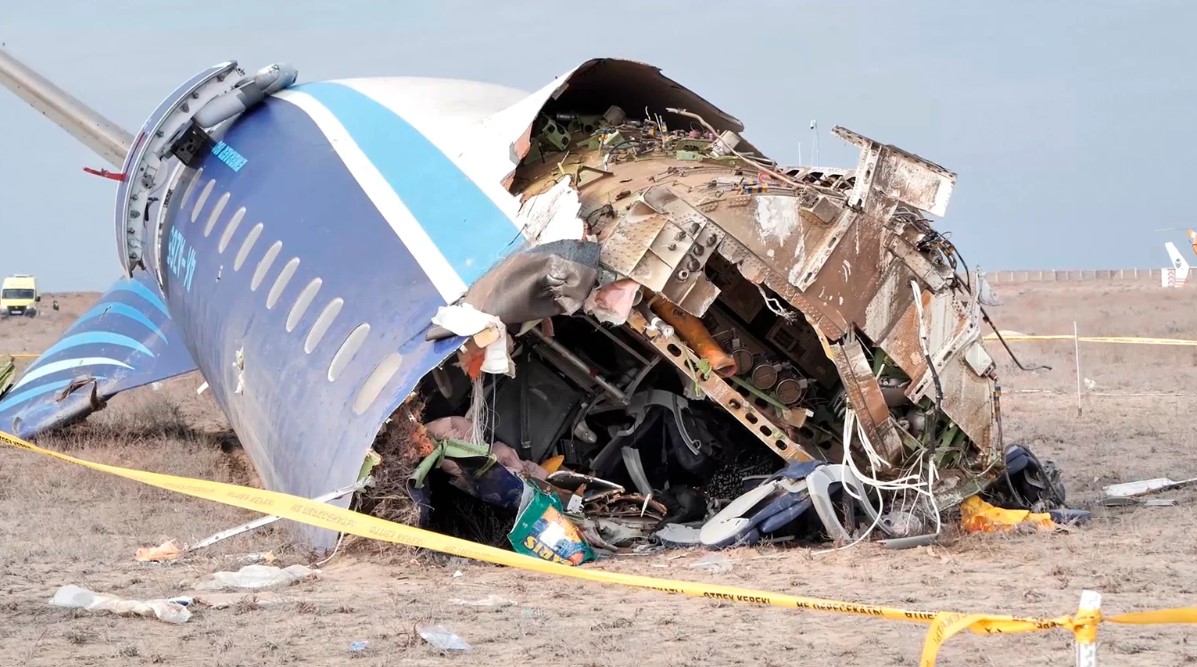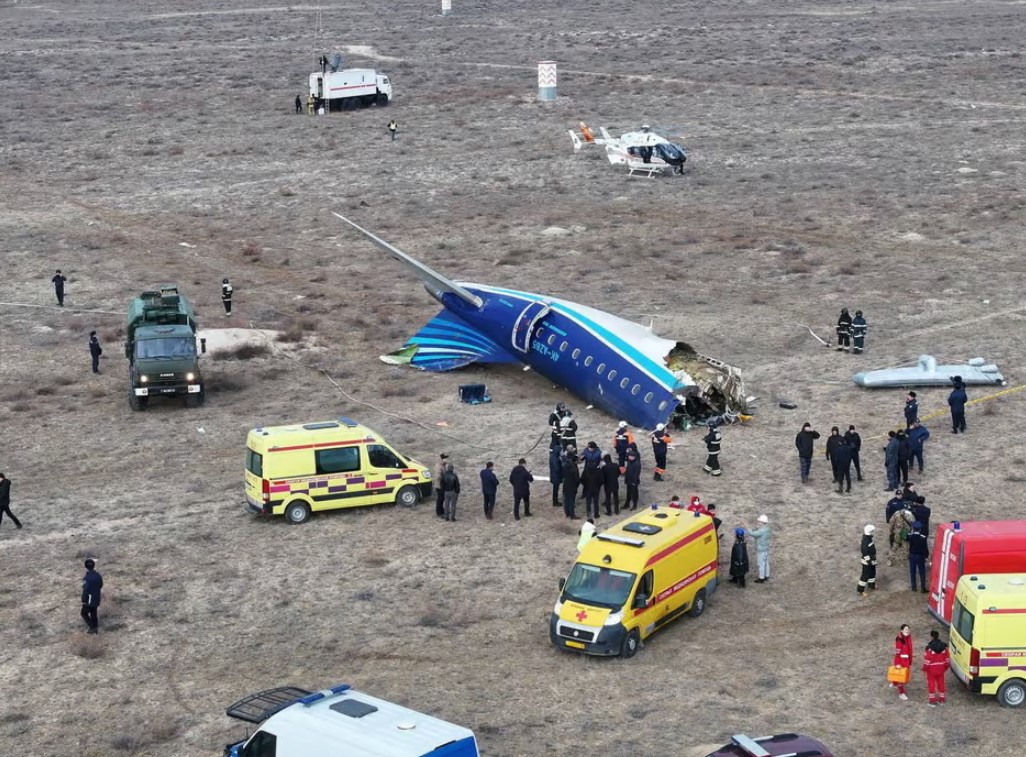On Christmas day, a harrowing event unfolded as an Azerbaijan Airlines passenger jet, Embraer 190, tragically crashed just outside of Aktau, Kazakhstan. The crash, documented through chilling new video footage from various cellphones, captures the jet’s devastating plunge to the ground, which resulted in a fiery explosion. This catastrophe claimed the lives of 38 individuals and left scenes of chaos and despair, deeply affecting families and communities across the region.


The flight, designated J2-8243, originally departed from Baku, the capital of Azerbaijan, and was en route to Grozny, Russia. However, the aircraft veered hundreds of miles off course, leading to speculations about the reasons behind this tragic deviation. Early reports suggested a possible bird strike as the catalyst for the emergency descent, though this theory was later complicated by revelations of an onboard oxygen tank explosion, adding layers of complexity to the ongoing investigations.
In the immediate aftermath, emergency response teams quickly mobilized to the crash site, where they were met with the grim reality of the wreckage and the urgent needs of the survivors. Of the 67 souls on board 62 passengers and five crew members 29 individuals were miraculously found alive and promptly hospitalized, including two children who survived the ordeal. These survivors, while fortunate to be alive, faced various injuries, with some in critical condition, necessitating swift and comprehensive medical care to address their severe traumas.
As the global community watches, the investigation continues to uncover the exact sequence of events that led to this tragic accident, with hopes that understanding this incident will prevent future tragedies. Meanwhile, the impact of this disaster resonates worldwide, prompting an outpouring of support and condolences from international leaders and citizens alike, all united in grief and solidarity with the victims and their families.
The Crash and List Video
On a solemn Christmas day, tragedy struck when Azerbaijan Airlines Flight J2-8243, an Embraer 190 passenger jet, met a catastrophic fate near Aktau, Kazakhstan. The aircraft, en route from Baku to Grozny, inexplicably deviated from its intended path, ultimately leading to a harrowing descent that ended in a violent crash. This calamitous event was not only captured on video by bystanders but also marked by a fiery explosion upon impact, claiming the lives of 38 of the 67 onboard.
Kazakhstan Plane Crash List Video
Initial theories surrounding the cause of the crash centered on a possible bird strike that might have disabled the aircraft. However, complications arose when subsequent investigations revealed that an oxygen tank on the plane had exploded, adding a new layer of complexity to the sequence of events that led to the aircraft’s fatal ground impact. This revelation has prompted further scrutiny into the aircraft’s maintenance records and operational protocols, as well as the environmental and air traffic conditions that could have contributed to the catastrophe.
The aircraft’s sudden and deadly descent shocked the local community and international observers alike. As it plummeted, the jet tore through the quiet skies of Kazakhstan, leaving behind a trail of debris and heartbreak. The crash site, a grim spectacle of mangled metal and personal belongings, painted a stark picture of the sudden and violent nature of the crash.
Emergency Response
The aftermath of the crash was chaotic yet met with immediate and courageous responses from emergency crews and first responders. Within minutes of the crash, sirens filled the air as a fleet of ambulances, fire trucks, and rescue vehicles converged on the scene. The first responders faced a daunting scene with flames engulfing parts of the wreckage and smoke billowing into the sky, creating a challenging environment for the rescue operations.


Survivors, some dazed and disoriented, were found amidst the debris. The scene was one of urgency, with emergency medical teams quickly assessing the condition of the survivors, providing first aid, and preparing for transport. The medical response was swift and organized, with local hospitals being alerted to receive casualties suffering from a range of injuries from burns to severe trauma.
Personal accounts from the survivors provided harrowing details of their experiences. One survivor recalled the terrifying moments of the jet’s descent, describing how passengers braced for impact, and the chaos that ensued once the aircraft struck the ground. Another survivor recounted the act of escaping through a broken fuselage, only to witness the devastating injuries of fellow passengers. These stories highlighted the severity of the crash and the miraculous nature of their survival.
Critically injured survivors were prioritized for immediate evacuation to specialized medical facilities. Among the survivors were two children who, despite the odds, were rescued and hospitalized with non-life-threatening injuries. Their survival brought a glimmer of hope to an otherwise dark situation.
The emergency response extended beyond the immediate physical injuries, with psychological support teams deployed to help survivors and the families of victims cope with the mental and emotional impact of the disaster. The community rallied together, with local citizens offering support and aid to the rescue operations and the families affected by the tragedy.
As the dust settled, the focus shifted to understanding the full scope of the incident and preventing future tragedies. The response efforts were widely recognized for their efficiency and compassion, underscoring the importance of preparedness and swift action in the wake of such disasters. Meanwhile, the aviation community and regulatory bodies began to scrutinize the factors leading to the crash, hoping to glean insights that could lead to safer skies for future flights.
Investigation and Theories
The investigation into the crash of Azerbaijan Airlines Flight J2-8243 has sparked a myriad of theories regarding the tragic event. Initially, the possibility of a bird strike was considered a likely cause. This theory stemmed from the route’s proximity to migratory bird paths commonly known to pose risks to aircraft. However, the complexity of the crash investigation deepened with the discovery that one of the plane’s oxygen tanks had exploded mid-flight. This unexpected twist suggested a mechanical failure that could have compromised the structural integrity of the aircraft, leading to catastrophic consequences.


Further complicating the investigation are speculations that the aircraft might have unintentionally crossed into airspace monitored by Russian air defenses. Given the heightened military alertness in the region, analysts have not dismissed the possibility that the plane could have been mistaken for a military threat, such as a Ukrainian drone. This theory is underpinned by the geopolitical tensions in the area, making it a crucial aspect of the ongoing investigation.
Eyewitness Videos and Descriptions
Eyewitness videos have provided a critical window into the final moments of Flight J2-8243. These videos captured the aircraft in a steep dive, engulfed in flames before impacting the ground near Aktau, resulting in a massive explosion. The footage shows chaotic scenes post-crash, with fire and black smoke rising from the wreckage. Survivors can be seen staggering away from the debris, some visibly injured, amid the sounds of sirens and shouting from rescue teams.
The personal accounts from these videos add a deeply human element to the tragedy. One video featured a survivor’s voice, shaking and breathless, describing the panic as passengers realized the gravity of their situation. Another clip showed a young woman, her face bloodied and clothes torn, being comforted by emergency responders as she cried out for her family. These personal stories, shared by survivors and witnesses, paint a vivid picture of the ordeal and the immediate impact on those involved.
International Reactions
The international reaction to the crash has been one of widespread shock and sympathy. Azerbaijani President Ilham Aliyev expressed his profound sorrow over the incident, emphasizing the national tragedy it represents for Azerbaijan. He confirmed that his government would support a thorough investigation into the crash and provide assistance to the families of the victims.
Russian President Vladimir Putin also issued a statement, extending his deepest condolences to President Aliyev and the people of Azerbaijan. He assured that Russia was ready to assist in the investigation and help in any way possible. These statements from both leaders highlight the gravity of the incident and its potential to influence regional relations.
The crash has significant implications for regional aviation safety and international diplomacy. It raises questions about airspace safety and the effectiveness of existing protocols in preventing such tragedies. Additionally, the incident could potentially strain relations in a region already tense with geopolitical conflicts and suspicions. It underscores the necessity for robust international cooperation in aviation safety and crisis management.
In conclusion, the crash of Flight J2-8243 has not only resulted in a tragic loss of life but also sparked a complex investigation that may have broader implications for international aviation safety and regional stability. As the world watches, the resolution of this investigation will be crucial in shaping future aviation safety protocols and international relations in the volatile region.
Historical Context and Aviation Safety
The tragic crash of Azerbaijan Airlines Flight J2-8243 occurs against a backdrop of escalating regional tensions and aviation safety concerns. Notably, the incident followed closely on the heels of a drone strike in southern Russia, highlighting the volatile security environment in the region. This event has had significant repercussions for aviation safety, with heightened military vigilance potentially affecting civil aviation routes and protocols.
This crash is part of a troubling pattern of aviation incidents in the region that underscore ongoing safety challenges. For instance, the downing of Malaysia Airlines Flight MH17 in 2014 over Eastern Ukraine during armed conflict highlighted the risks of commercial flights over conflict zones. Similarly, the 2020 downing of Ukraine International Airlines Flight PS752 by Iranian air defenses mistakenly identified the aircraft as a hostile target. These incidents collectively spotlight the critical need for robust risk assessments and the implementation of more stringent air travel safety measures, especially in regions experiencing geopolitical strife.
The crash of Azerbaijan Airlines Flight J2-8243 is a profound tragedy that has touched many lives and sparked a complex international investigation. The incident not only claimed 38 lives but also left several survivors with severe injuries, necessitating a long and difficult recovery process. The ongoing investigation aims to uncover the precise causes of the crash, with early theories ranging from a possible bird strike to an oxygen tank explosion, and even speculation regarding an encounter with military air defenses.
This devastating event serves as a stark reminder of the imperative for stringent aviation safety protocols and the need for constant vigilance in the maintenance and operation of all aircraft. It also highlights the complex interplay between regional conflicts and civil aviation safety, underscoring the necessity for enhanced cooperation and communication among countries to safeguard the skies.
In light of this tragedy, there is a clear call to action for all stakeholders in the aviation industry from airline operators and regulators to international safety organizations to reevaluate and strengthen safety measures. The aim must be to prevent such disasters from occurring in the future and to ensure the safety of passengers and crew across all flights, regardless of the geopolitical tensions that may exist on the ground.
As we reflect on this incident, our thoughts remain with the families and friends of those who lost their lives. Their grief is shared by many around the world, and we extend our deepest condolences. To those recovering from injuries, we express our hopes for a full and speedy recovery. It is our collective responsibility to learn from this tragedy and implement the necessary changes to make air travel safer for everyone, reaffirming our commitment to the sanctity of human life and the pursuit of peace and safety in aviation.
Daily Hot News –



